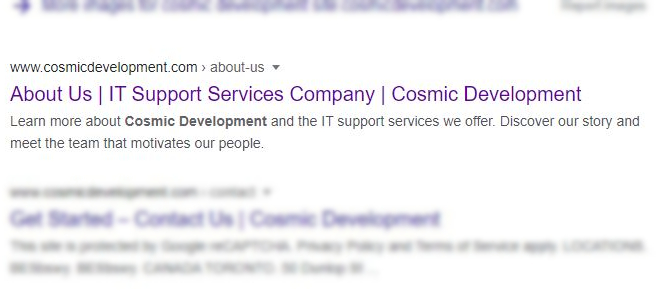by Viktorija Nikoloska
Are you searching for the basic writing guidelines to help you with writing blogs for your specific target audience and customers? If the answer to this question is ‘Yes,’ then you are in the right place. By reading this article, you will learn what a good blog post is and how to write it, but most importantly, you will discover the basic writing guidelines that will lead you through writing a blog post for your website.
With the digitalization settling in every aspect of our lives, we must increase our online presence and pay more attention to our audience’s interests. The best way to achieve this is by creating a content marketing strategy with implemented Search Engine Optimization (SEO), which will increase your company’s presence and traffic.
The writing guidelines in this article will teach you how to optimize your article for search engines such as Google and guide you through the process of writing blogs. You will get answers to what are keywords and how to conduct a keyword analysis for a specific topic. You will also learn how to write meta titles and meta descriptions and why they are essential. And finally, you will enrich your knowledge of the most important grammar writing guidelines that a professional blogger and editor should follow.
Read more about How Rumble’s Content Editor Nick Naumoff Chooses the Best Content Ideas for Rumble’s website or click on the image below and schedule a free IT consultation

Keywords, also known as ‘Key Phrases’ or ‘Search Queries,’ are the words that people enter in search engines when looking for something online. From the company’s aspect, they are the ideas and topics that define your content’s purpose. In terms of SEO, keywords are the words and phrases that searchers enter into search engines. Companies use strictly-defined keywords according to the products or services they offer so that their businesses may rank higher in the Search Engine Results Pages (SERPs) when people search for those keywords. The main target of business owners is to use keywords on their websites that will bring them higher chances of getting more website traffic. For that purpose, content creators and SEO analysts will have to conduct keyword research to ensure that the keywords they will use on the website and blog are relevant and searched for.
Therefore, I can say that the most crucial part of these writing guidelines is to learn how to conduct a keyword analysis. Keywords are essential for creating an article. Keywords are important because they represent the connection between what people are searching for and the content that is written for that purpose. Moreover, they help in ranking higher on SERPs, thus driving organic traffic to your website. The keywords chosen by an SEO analyst will determine what kind of traffic you get.
Example: If you are offering software development services, you may want to rank for “python programming language,” – but if you’re not careful, you may end up attracting traffic interested in the family of snakes – python.
Business owners usually want to have content that ranks well organically and drives visitors to their websites. However, they need first to understand their reader’s language and the type of content they seek. They can do this by talking to the customers, by conducting keyword analysis, or by frequenting forums and community groups. Nowadays, there are various tools for conducting a keywords research. You can choose whichever suits your needs. The choices vary from browser extensions such as the Keywords Everywhere and Google’s product Keyword Planner to SEO software such as Moz, digital marketing toolkit such as SEMRush, and start-up companies that offer marketing tools such as Ahrefs. 
Image source
What is a Meta Title?
The meta title is, in fact, the title of the HTML document. Both browsers and SERPs use meta titles for displaying preview snippets of the landing page. Meta titles describe the article’s purpose and inform Google of that purpose.
Ideally, meta titles should be between 50 and 67 characters (580 pixels long) and concisely explain a specific topic or phrase. From my personal experience, the optimal length of a meta title is 55 characters.
The meta title consists of the article title followed by a vertical bar, with space before and after, followed by the website name. Every meta title must contain a major keyword; however, it must not contain any periods.
What is a Meta Description?
Meta descriptions explain the functions and the purpose of the page shown, and it is displayed immediately below the Meta Title on a SERP. The main focus of the meta description is to contain concise and thorough sentences that will make an emotional impact on the readers, thus enhancing the user experience. Meta descriptions must contain action words that may vary based on what the users will find on the page. If the page is informational, point out the information that they will read.
Meta descriptions should contain from one to three keywords, depending on the length of the keyword itself. When creating a meta description, you should already have a list of keywords that you will use throughout the article. Think of keywords that people mostly search for. If possible, make sure to add keywords to the beginning of the phrases in the meta description.
Meta descriptions must be between 120-158 characters. Try not to go over 158 characters (919 pixels long); otherwise, you run the risk that Google cuts the description off. Unlike meta titles, the meta descriptions contain sentences, so you need to add a period at the end of each sentence.
This is an example of a meta title and a meta description. The meta title consists of the page title “About Us | IT Support Services Company”, followed by a vertical bar (|) and the name of the company “Cosmic Development”:
About Us | IT Support Services Company | Cosmic Development
The meta description is the text below the meta title:
Learn more about Cosmic Development and the IT support services we offer. Discover our story and meet the team that motivates our people.
The main keyword used in both the meta title and the meta description is: IT support services
What are the Basic Rules for Writing a Blog?
Blog Post Length
We are aware that nowadays, people’s attention span is several seconds and that no one wants to read long blog articles. However, the blog post length is one of the essential writing guidelines for a successful blog article. Google usually prefers longer articles that contain relevant keywords according to the article’s topic. It is a general rule that longer posts tend to rank better because they cover the issue more thoroughly, and Google considers these articles as expert articles. Therefore, the ideal blog post length would be above 2,000 words. Those articles should usually be from five to seven minutes of reading time.
Furthermore, when considering the blog post length, you also need to have in mind the readers and not only the search engines. After all, you are also writing for the readers, not for the search engines alone. After conducting thorough research of your blog audience, you will be able to determine the length of your blog posts. However, the articles should not contain less than 1,000 words, which is approximately a post of three minutes of reading time. Besides, keep in mind that the blog post length is also dependent on the keywords you choose for the article.
Language Usage
When writing a blog article, you should use plain English language, which will be equally understood by both native and non-native readers. Make sure that you blend the tenses wisely and that you mostly use the present tense. Moreover, make paragraphs short and break them up with lists, bullet points, and subheadings. Use collective nouns and avoid writing in the first person singular, because it is considered as informal. Try to use the third person when writing articles, to avoid informal texts. Both second and third persons are acceptable voices, so long as you are consistent with it in a given sentence or paragraph.
Furthermore, make sure that you avoid fluffy writing when creating your blog article. Fluffy writing is actually writing that is done simply to reach the word count. Every paragraph that you have in your article should provide valuable information to the reader. No one wants to read articles written simply to meet the word count. Everything you write should provide useful information to the reader concisely and cleanly.
Tone of Voice
The usage of active voice should be dominant in your blog articles, while you must avoid the passive voice. The article’s tone should be direct and informative. A passive voice gives the idea that the writer is not sure about the content provided. Active voice, on the other hand, projects confidence and authority. When it comes to the tone of voice, there are seven rules that you should follow throughout all blog posts:
Human, not impersonal
Conversational and engaging
Knowledgeable, not professorial
Professional, not corporate
Confident, not arrogant
Straightforward, not rude
Friendly, not colloquial
Structure Tips
When writing a blog post, you need to pay attention to the beginning of the article. At first, you need to create a topic sentence that will serve as an opener of your article and will catch the reader’s attention. Therefore, make sure to take your time when crafting this topic sentence. Secondly, you need to have an irresistible introduction to the article. You can start by creating an attention-grabbing hook, for instance, using a metaphor, asking a question, telling a story, using statistics or facts, etc. And finally, you must include the keywords that you chose for the article at hand. Make sure to place the keywords in the meta title, meta description, subheadings, image alt tags, and throughout the entire article.
Pronoun Agreement
When writing blogs, content creators need to ensure that they have a pronoun agreement both within the sentence and within the paragraph. What does this mean? It means that if, for instance, you are writing in the third person singular, you need to continue using nouns of third-person singular throughout the entire paragraph.
Wrong: “The applicant must apply to their office.” “Applicant” is a third-person singular noun. “Their” reflects a third-person plural noun.
Correct: “Applicants must apply to their office.” or “The applicant must apply to his/her office.”
When writing official and expert articles, you should choose to avoid personalization (he/she). Therefore, it is better if we write persons in the plural. Moreover, make sure to use proper pronoun agreement with a collective noun. Since a collective noun (the team, the agency, the department, the company, etc.) represents a singular unit, a singular term must follow, not a plural one.
Wrong: “To contact the department, call their number.”
Correct: “To contact the department, call its number.”

Important AP Style Writing Guidelines
The AP (Associated Press) Style is a writing style that every journalist or content creator must know by heart. The Associated Press has published numerous editions of their AP Stylebook so far, abounding with writing guidelines that writers and editors must follow if they want to produce qualitative pieces of writing. Blog editors are encouraged to follow the AP Styleguide when it comes to online content. AP Style is used to format numbers, dates, addresses, and much more. Below are listed some of the most important writing guidelines according to the AP Stylebook:
- Only use single spacing – Do not double-space after the end of a sentence.
- Be mindful of when to write out the number and when to use the digits.
- Write out numbers when they start the sentence unless it is a year date. Examples:
- Twenty-five years ago, shoulder pads were popular.
- 2007 saw a quick resurgence of the trend.
- Write out numbers from one to nine. From 10 on, you use the digits. (11, 12, 134, 155)
- Ages: all ages should be written out in figures: 1 year old, 2 years, 3 years, 4 years of age, etc.
- Write out percent. Five percent chance of rain.
- It is not AM or pm. It is 7 a.m. and 7 p.m. (do not include the :00 — you only include real minutes, like in 7:21 a.m.)
- Years: the 1960s, the 2000s (no apostrophes are necessary)
- Use double quotation “marks”, not single ‘ones’.
For more detailed writing guidelines, download the latest edition of the AP Stylebook.
OR
Schedule a free IT consultation with our experts and let us help you compose a successful blog post.

Sources:

